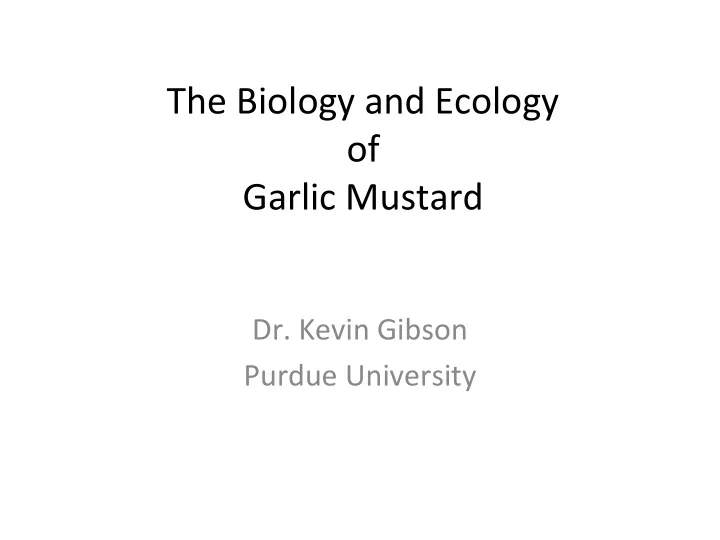

The Biology and Ecology of Garlic Mustard Dr. Kevin Gibson Purdue University
Outline • Life cycle and distribution • Why is it invasive? • Impact on native plant communities • Role in forest change – Earthworms – Potential adaptation by native species • Management implications
Garlic Mustard Life Cycle () Photo by Doug Landis Photo by Doug Landis
Distribution
Why is it invasive? • Release from natural enemies • Phenology • Reproduction • It produces nasty compounds
Why is it invasive? • Release from natural enemies – Many more herbivores (69 insect spp.) in native range (Szentesi 1991) and herbivory is greater in native range. – However, garlic mustard does not have greater growth or reduced allocation to defense in invaded range than in native range (Bossdorf et al. 2004) – White ‐ tailed deer may reduce competition by consuming native plant species and disturbing the soil with their hooves (Nuzzo 2000).
Why is it invasive? • Phenology – Maximum photosynthetic rates achieved before many native species emerge (Myers and Anderson 2003). – Overwinters as green rosette • Reproduction – 3,500 seeds per plant, 9500 seeds m ‐ 2 in northern Illinois (Nuzzo 1993) – Adapted to generalist pollinators – Virtually all pollinated ovules develop into seed – High levels of population cross ‐ pollination maintains high level of genetic variability – Virtually all second year plants produce flowers
Emergence and survival 80 -2 ) Plant density (individuals m 44% 70 60 50 40 30 20 25% 10 18% 28% 8% 0% 0 0 1 2 3 4 5 6 7 8 9 10 Cohorts
Why is it invasive? • It produces nasty compounds – Glucosinolates – Cyanide (Cipollini and Gruner 2007) • It suppresses soil pathogens and pests (Klironomos 2002), facilitating its own invasion. • It suppresses mycorrhizal fungi, accelerates decomposition, and increases N availability (Rodgers et al. 2008). – Many native forest species are AMF dependent – Garlic mustard establishment is reduced by leaf litter (Bartsuzevige et al. 2007)
Impact!
Stinson et al. (2007)
Impact • McCarthy (1997) – Removal of garlic mustard increased native annuals, vines, and tree seedlings within first year • Meekins and McCarthy (1999) – Box elder ( Acer negundo ) and jewelweed ( Impatiens capensis ) biomass greater with garlic mustard than in monoculture – Chestnut oak ( Quercus prinus ) had opposite response. • Hochstedler et al. (2007) – Cover of native spring perennials and graminoids increased within two years of herbicide applications – Cover of annuals decreased slightly after five years of applications
Additional impact • West Virginia white butterfly ( Pieris virginiensis ) lays eggs on garlic mustard. Hatching is lower on garlic mustard than on native species (Porter 1994). • Mustard white butterfly ( Pieris napi oleracea ) – Field mustard and wild radish are primary hosts – Garlic mustard can serve as alternate hosts – Larvae have lower survivorship on garlic mustard than on native plant hosts – Models suggest that garlic mustard is a major factor in the decline of this butterfly species.
Forest change • Garlic mustard is one among many plant and animal invaders. • Earthworms may facilitate garlic mustard invasion – Garlic mustard dominant on sites with earthworms (Hale 2004) – Fewer herbaceous species, lower cover, reduced litter layer – Shift from slower cycling fungal dominated system to rapid bacterial dominated system
Bohlen et al. (2004) Site with earthworms Site without earthworms
Adaptation • Keeler et al. (2008). Escaping an evolutionary trap: preference and performance of a native insect on an exotic invasive host. Oecologia 156:559 ‐ 568. • Compared oviposition preference and larval performance of P. oleracea on garlic mustard in areas with and without garlic mustard. • Females preferred GM and larval survivorship was positively correlated with mother’s preference in area with GM. • Females had wide range of preference of host preference in area without GM and very low larval survival on GM. • P. oleracea may be adapting to GM in areas where the weed is well ‐ established
Management Implications • Garlic mustard has a suite of adaptations that contribute to its ability to invade and substantially alter forest systems. • Garlic mustard may be as much a symptom as cause of forest change. • Eradication is not possible at the regional level; local control will require a sustained effort.
Management Implications • Garlic mustard phenology may allow local management without damaging native species. • Biocontrol may allow regional control that reduces garlic mustard impact.
Recommend
More recommend